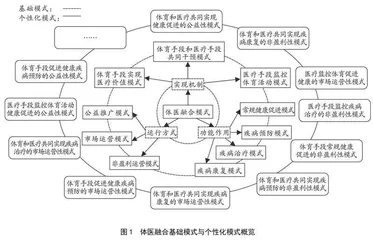我国体医融合模式提炼与推广路径
作者: 刘耀荣 段昊 吴香芝

摘 要:通过文献资料、网络查询、专家访谈等方法,从我国体医融合实践中提炼出若干体医融合模式,并设计体医融合模式推广路径,以扩大体医融合范围、深化体医融合力度。基于体医融合理论与实践,提炼出体医融合基础模式,如以体育和医疗融合的实现机制为依据提炼出体育手段实现医疗价值模式、体育手段和医疗手段共同干预模式;以体医融合的功能作用为依据提炼出疾病治疗体医融合模式、常规健康促进体医融合模式;以体医融合实施机构运行方式为依据提炼出非盈利运营模式、市场运营模式。与此同时,提炼出一些体医融合的个性化模式:体育和医疗共同实现健康促进的公益性模式,如校园、公立养老院、企事业单位等;体育和医疗共同实现疾病康复的非盈利性模式,如综合性医院、康复医院、社区医院等。提出我国体医融合模式的推广路径:形成低成本、快效益、高效能、易操作的体医融合模式推广思路;坚持实事求是、重视技术、市场运营与公益推广相结合的推广策略;设计体医融合模式与社会资源匹配的线上线下推广方案;建立指导、评价、反馈和调整的体医融合模式优化机制。相关机构和主体应该重视体医融合模式形成的理论基础和实践形式,选择迎合社会需求的体医融合模式,并对其科学推广,以推动体医融合高质量发展。
关 键 词:体医融合;模式优化;健康促进;健康中国
中图分类号:G80-05 文献标志码:A 文章编号:1006-7116(2023)03-0032-08
The promotion and popularization path of physical-medical
integration mode in China
LIU Yaorong DUAN Hao WU Xiangzhi
(1.Department of Graduate,Xi’an Physical Education University,Xi’an 710068,China;
2.School of Physical Education,Jiangsu Normal University,Xuzhou 221116,China)
Abstract: Through the methods of literature, network query and expert interview, the physical-medical integration mode was extracted from various practices of physical-medical integration in China, and designs the promotion path of physical-medical integration mode so as to deepen the strength and expand the scope of physical-medical integration. Based on the theory and practice of physical-medical integration, some basic modes of physical-medical integration were extracted. For example, based on the realization mechanism of physical-medical integration, sports means can realize the mode of medical value and the joint intervention mode of sports means and medical means; based on the function of physical-medical integration, the physical-medical integration model of disease treatment and the physical-medical integration model of routine health promotion were extracted; based on the operation mode of physical-medical integration implementation institutions, non-profit operation mode and market operation mode were extracted. At the same time, some personalized modes of physical-medical integration are extracted: physical and medical care jointly realize the public welfare mode of health promotion, such as campus, public nursing homes, enterprises and institutions; physical and medical care jointly realize the non-profit mode of disease rehabilitation, such as general hospital, rehabilitation hospital, community hospital. The popularization path of physical-medical integration mode in China is proposed as follows: forming a low-cost, fast benefit, efficient, easy ideas to popularize the physical and medical integration mode; adhering to the promotion strategy of seeking truth from facts, attaching importance to technology, market operation and public welfare promotion; designing the online and offline promotion plan matching the physical-medical integration model and social resources; establishing the optimization mechanism of physical-medical integration mode for guidance, evaluation, feedback and adjustment. The relevant institutions and subjects should attach much importance to the theoretical basis and practical form of physical-medical integration mode, select the physical-medical integration mode that meets the social needs, and promote it scientifically, so as to promote the high-quality development of physical-medical integration.
Keywords: physical-medical integration;mode optimization;healthy promotion;healthy China
《关于加强健康促进与教育的指导意见》《国民营养计划(2017—2030年)》《国务院关于实施健康中国行动的意见》《国务院办公厅关于促进全民健身和体育消费推动体育产业高质量发展的意见》《全民健身计划(2021—2025年)》等相关政策文件均强调要加强非医疗健康干预,发挥体育与医疗在疾病防治以及提高人民健康水平的作用,引导人们形成体医融合健康促进理念,鼓励社会组织机构建立与之相适应的体医融合实践模式。在新冠疫情防控背景下,人们对体医融合高效促进健康、快速恢复、提高免疫力有着迫切需求。国内很多学者从体医融合的实践方案、协同治理、资源共享、服务方式等视角进行探讨,提出“体医融合”若干模式,譬如运动处方门诊模式、医院健康指导模式、社区体育俱乐部模式、“双螺旋”式融合模式、“嵌入”式融合模式、产学研模式等[1-4],为我国体医融合模式的形成提供理论参考;但对体医融合模式的基础理论研究和实践经验分析不足,在现实中推广或复制的难度大。从体医融合体现的现实样态为根本,从相关理论依据出发,基于实现机制、功能作用和运行方式提炼出多样化的体医融合模式,最后根据各类体医融合模式规律和特点,提出适宜的推广路径,对扩大我国体医融合范围、深化我国体医融合力度,助力健康中国和体育强国建设具有重要作用。
1 体医融合理论基础与实践样态
1.1 体医融合的理论基础
1)体育的医学价值理论。
体育的医学价值是通过科学的身体活动给予人体各生理系统一种良性刺激,促使身体的形态结构、生理机能等方面发生一系列适应性的反应和变化,达到健康促进、增强体质、预防疾病等作用[5]。20世纪90年代初,初步形成现代体育的医学价值理论,通过传统体育功效与医学功效的互补性[6],实现体育运动对脊椎病、腰背疼痛等外科疾病的辅助治疗[7-8]。进入21世纪,形成了体育锻炼对高血压、糖尿病、抑郁症等慢性疾病的辅助治疗的理论价值[9-11]。到目前为止,体育的医学价值理论主要以传统体育养生、慢跑、快走等中低强度活动的理论为主;中低强度的有氧运动可以促进健康或恢复身体机能,改善心血管病患者的心脏功能、降低高血压患者的血压、降低糖尿病发病率,并在实践中实现患者的生存率,降低患病率、死亡风险、再住院率等[12-14]。国外体育的医学价值理论最早形成于中低强度有氧运动的医疗价值,有规律性的中低强度有氧体育活动能够缓解心理压力、预防和治疗结肠癌、心脑血管疾病、糖尿病、肝病等疾病[15-17]。随着体育的医学价值理论不断深入和扩展,高强度运动的医学价值理论逐渐形成,高强度训练或力量训练可以改善慢性疼痛、辅助治疗关节炎等病症[18-19]。
2)体育和医学共同促进健康理论。
体育和医学共同促进健康理论是指通过医学思维方式和知识体系将常见的体育运动方法进行归纳和总结,使其处方化、科学化,形成稳定的理论与技术共识,是运动医学、体育保健、健康评估、运动处方等众多理论的集合[20]。我国近几年逐渐形成体育和医学共同促进健康方案,旨在通过体育和医学的共同干预实现更有效健康促进效果。体育和医学共同促进健康的理念、概念和内涵逐渐形成并不断完善[21],为成立体育康复医院、培养体医融合人才[22],在体育和医学共同促进健康的理论指导下,形成共同促进健康的体医融合方案。
3)体育健康促进的医疗技术监控理论。
体育手段在预防疾病和康复治疗中发挥各种作用,但实施过程中的医疗技术监控非常重要。体育健康促进的医疗技术监控理论是指借助医学手段、医疗器械、医学人工智能等,为体育运动促进健康提供检测、控制和调节的理论体系[23]。在医疗技术监控理论指导下,通过可穿戴传感器、计步器、电子手表等设备检测数据,运用远程监控系统、内置传感器、心电传感芯片等监测人们心率、血压、体温、血氧饱和度等指标,依据人工智能AI、手机软件App等分析报告,随时了解自身健康状况[24]。与此同时,承担疾病预防和康复治疗的体育活动也需要医疗技术的监控。在高血压、心脏病、运动性损伤等病症的康复阶段,通过电子设备进行实时监控,一方面可以参考指标数据制定科学性、个性化的运动方案,增强患者的体质健康;另一方面使患者了解相关疾病指标的波动状况,在合理的时间内采取适宜的运动负荷与运动方式,促使患者快速恢复健康生活[25]。
1.2 体医融合模式的实践样态
1)我国体医融合历史渊源。
我国西汉时期的“导引术”是体育医疗价值的最早体现。尽管历史典籍并没有明确提出“体医融合”的概念,但通过身体运动基于“于外而内”“内病外治”“养备而动时,则天不能病”的理念与方法,其本质与“体医融合”的内涵一致[26]。先秦古籍《吕氏春秋》“筋骨瑟缩不达,故作舞以宣导之”,体现了原始舞蹈是一种健康促进的保健活动;隋代《诸病源候论》“养生方导引法”,作为疾病的康复指导,针对各种病症开具了针对性的养生方导引法,与现代运动处方思维较相近;宋金元时期气功、武术、导引等健康促进方式变化多样,具有强身健体、健康促进的功能作用;明清时期传统体育养生达到兴盛阶段,改造、创编陈希夷坐功、易筋经等许多以套路为形式的导引功法,让体育手段促进健康的医疗效果更具针对性与时效性[27]。这些体育活动的医疗价值对现代体医融合的延续性与推广依然具有借鉴价值。